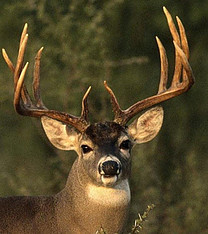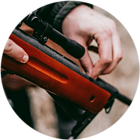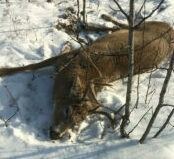 When people ask “what is deer hunting?”, they often get a somewhat sarcastic response or more of a dictionary definition rather than the answer to the question they really want to know. “What is Hunting Like?”
When people ask “what is deer hunting?”, they often get a somewhat sarcastic response or more of a dictionary definition rather than the answer to the question they really want to know. “What is Hunting Like?”
If you are looking at getting into hunting you probably already understand that hunting is killing an animal for either food or sport or both. Keep in mind jurisdictions will require you to keep the meat of some animals and/or the fur of others.
Hunting isn’t just killing or “harvesting” an animal. We believe that when someone asks what is deer hunting, or hunting in general, they are actually asking “What is hunting like?” That question requires a much more detailed answer. Luckily you found a good’ole Canadian couple who like to be helpful and will give you the truth about hunting, including the joys and frustrations (believe me, there are plenty of both).
To give you a full answer to the question that brought you here, I will break it down into five categories using our experience with Canadian deer hunting. First, I will give you a list of activities that typically fall under the legal definition of hunting. Second, I will cover some common approaches to hunting or types of hunting. Third, I will cover the importance of Hunting Regulations. Fourth, I will explain what you need to know before and after the shot. Fifth, I will share the reality of hunting. Lastly I will let you know why we choose this pastime.
(We will be referencing deer, but the concepts are similar for most large game.)
DEER HUNTING DEFINITION
Hunting is a regulated sport and because of that you need to be aware of the potential legal definitions and not just know how to shoot an animal. This is the equivalent of saying you can drive a car because you drove one on a farm versus actually knowing the rules of the road and passing a recognized Driver’s License exam.
Hunting isn’t just the act of pulling a trigger or letting an arrow fly. You get a better picture of what hunting is when you think of one animal hunting another, where they don’t make use of human technologies. The following is a list of terms you may see when you look at your local hunting regulations that are all classified as “Hunting”. (this list is not all-inclusive)
Hunting Terms
- Shoot at
- Harass
- Worry
- Chase
- Pursue
- Follow/Trail
- Search for
- Flush
- Stalk
- Lie in wait
- Capture / attempt to capture
- Willfully kill / willfully attempt to kill
If you are doing any of the items listed above for yourself or with someone else you would be seen, from a legal perspective, as “hunting”. What you need to understand is that each of these items alone take you into the realm of hunting. If I am stalking or pursuing a deer without a gun or bow, I am still subject to the rules and regulations in the jurisdiction related to hunting and specifically hunting deer.
COMMON TYPES OF DEER HUNTING
Alright, when people think about hunting this is normally where they jump in (how do I get an animal). I am going to let you know about three types of hunting that are most common and which most people seem to gravitate towards.
- Road Hunting. This is probably the easiest for a lot of people to get started with and involves the least amount of gear and possibly the least amount of physical exertion. Essentially, road hunting is hunting, as defined above, from the comfort of your vehicle. You will access roads that you have permission to hunt from (either private property, or depending on where you live it could be government/crown land). We live in Alberta, Canada, and logging roads and oilfield roads often exist on what is called Crown Land (government owned and allowed to be accessed by any citizen).Once you know which roads you are allowed to hunt from, you drive up and down these roads most likely with your rifle and binoculars. When you see a deer you are allowed to “harvest”/kill, you stop the vehicle, get out and try to shoot the deer before it spooks and disappears. If you are lucky, you get the deer and it is relatively close to your truck, so there is less recovery involved. The cost of gas and minimal gear makes this method cheap in comparison to some other methods.
- Spot & Stalk Hunting. Picture this as road hunting, but instead of in your truck on the road, you are on foot and in the bush or on trails. To be successful you want to find an area you are allowed to hunt, and where you know there is a population of deer. You then hike through the area and hope to come across a deer, ideally not just seeing the iconic white tail and not the rest of the deer.Once you “spot” your target deer, you then “stalk” until you are close enough to make an ethical shot. Similar to road hunting, if you are lucky, you now have a fresh harvest. Now some hard work comes into play. You need to get the animal out of the bush and back to your vehicle. I will talk about recovery another time. Recovery of a deer is usually not too difficult, and because you are using less gas for your vehicle, this is definitely the cheapest Whitetail deer hunting that we do, and honestly it is our preferred method.
- Blind/Stand Hunting. This is the most gear intensive of the three kinds of hunting that I am covering in this article. Blind or Stand hunting is basically Spot & Stalk without the Stalk. For this type of hunting you either need to have a blind or tree stand, or you need to make one.A blind or stand is placed on land that you have permission to hunt on, where you believe there is a high amount of deer traffic. You ideally will set-up where you will have firing lanes (open / clear view of the path you will shoot) towards the game trails. This type of hunting assumes the deer are coming to you, and will allow you to test your patience. You will wait silently in the blind or stand, until the deer comes down the game trail. When the deer gets to a point where you can make an ethical shot, you attempt to harvest your animal.Similar to Spot & Stalk, now you have your harvest to get out of the bush, as well as eventually needing to get your blind out of the bush (even if it is only at the end of the season).This method is the more costly of the methods I have mentioned since you require more gear. Keep in mind that this is an investment and after the initial cost you will not have the same recurring costs each year.
All the types of hunting above can involve different accessories like calls, etc. Those types of items I will talk about at another time as it can get complicated. Examples of those complications would be where regulations specify whether you can use electronic calls or not, if you can use scents, what types of scent are allowed, etc.
Karolina and I were both exposed to hunting initially through Road and Spot & Stalk hunting. As mentioned, they are the cheap or at least cheaper ways to get into hunting.
DEER HUNTING REGULATIONS
There is a legal aspect to most things in life right now and hunting is no different. As Canadians, Karolina and I are subject to Federal, and Provincial Regulations covering Migratory Bird Hunting as well as Big Game and Upland Game Birds. That isn’t even taking into account all the regulations related to our firearms licenses.
Without getting into specifics, as every location is going to be different, I will talk about the key elements you will need to be aware of, at minimum. Always check your local regulations to see what requirements you may have that differ from other areas.
First, you need to understand that Regulations are rules that are enforced by an authority. So in essence, they are legal requirements or rules that you have to comply with. When it comes to hunting some items you will need to be aware of, which will be outlined in your regulations, are:
- Do you require some Formal Hunter Education course prior to hunting
- Do you require different permits to use a bow, crossbow, muzzle-loader, rifle, or shotgun (in Alberta, Canada we require a Bow permit if hunting during Bow season)
- What firearms and ammunition are legally allowed for each type of animal you are hunting
- Do you require a general license that allows you to buy hunting licenses (we have a license that is required [“WIN Card”] to then buy hunting or fishing licenses)
- Are your “Tags” general or draw
- Do you need to report your harvest to someone or some authority
- How many tags are valid per hunting zone
- What animals are you allowed to hunt in each zone
- Are there size requirements or gender requirements on the animals you are hunting
- What situations are you not allowed to harvest under (example: you can’t shoot a swimming animal, you can’t hunt an area you have flown over within the last X number of hours, you cannot shoot from a vehicle, or across a road, etc…)
- What part of the animal MUST be kept. Do you need to keep the meat, or the fur, or both
- What devices are you allowed and not allowed to use (electronic versus manual calls), bait, etc…
- Are there rules regarding transport, selling, giving away
- What times of day are you allowed to hunt
As you can see from the sample of items above, Regulations cover a number of things that a non-hunter may not even realize come into play. Hunting is not just shooting a deer and now you have a full freezer. Hunting is also being aware of rules and regulations, paying fees, reporting, and checking for Regulation changes every year to ensure you are compliant. Remember this part is just about the act of hunting as defined above. You will also have a bunch of other regulations/laws with regard to your preferred method hunting whether it be bow, or gun, or something else.
BEFORE AND AFTER THE SHOT
This one I will keep relatively simple and break it out into two categories:
- Before the Shot. Before the shot basically comes down to, “are you prepared?”
- Have you read the Regulations and understand them for deer hunting in your selected area

- Do you have the appropriate tags
- Have you obtained permission to hunt on the land you want to hunt
- Do you have the supplies necessary to harvest/recover your deer
- Do you have emergency supplies in-case of injury, or getting stuck in the bush
- Have you practiced with your rifle or bow to have confidence in your shot placement
- Have you read the Regulations and understand them for deer hunting in your selected area
- After the Shot. This isn’t as extensive if you have done what is required before the shot. The difference is this involves more physical exertion
- You will need to field dress the deer (remove the organs)
- Transport the animal (get it from the bush to your vehicle, then to either a reporting station, butcher, or residence)
- Report to the proper authorities, if required
- In the case of deer, butcher the animal, which will include skinning.
- Keep in mind some butcher shops may not process wild game due to health regulations, so you may want to find this out beforehand. You may also want to butcher your deer yourself, so what tools and training, if any, will you need.
Honestly, loading the truck for the weekend with all the supplies, and then dragging the deer from the bush, field dressing then butchering it are the more onerous parts of hunting. Everything else becomes simple after the first season or two. You get to know the regulations so you just need to keep updated on the changes from one year to the next. The physical hunt usually doesn’t feel like a task, that is the fun part, the reason we get out into the bush.
REALISTIC EXPECTATIONS OF DEER HUNTING
For realistic expectations of hunting I am going to share a couple of little stories to let you know what happens out there compared to what you see on hunting shows, where everything seems to be a trophy animal.
Scott’s First Deer Hunting Season
When I was introduced to hunting it was Spot & Stalk with some Road Hunting between the areas we were walking. Keep in mind I am originally from a large metropolitan city and had never been out hunting before. On top of that I am now in Alberta, Canada which has temperatures in the winter that reach -40 (that is the same in Celsius and Fahrenheit).
When I was taken out to see the hunting area and sight in rifles, the person who was introducing me to hunting saw a deer from the truck while driving on an oilfield road. He stopped, got out of the vehicle and took about 10 steps into the bush. After a couple of seconds a shot was fired and a whitetail buck was down about 30 feet further in the bush. The deer was tagged, field dressed and in the truck within 20 minutes. Doesn’t seem too difficult, does it?
The Issues Scott Faced
My experience as a hunter was a little different. I spent two months walking the bush whenever I could, as well as driving the roads. Meanwhile, the guy exposing me to hunting harvested a couple more deer (we were allowed three Whitetail deer each in that zone). I spent hours and hours in the bush in the freezing cold at times and not seeing much. When I did see a Whitetail deer it was often too far to attempt a shot or saw me first and was on the run when I noticed.
On the last day of the hunting season, with nothing to show for it, and exposed to -40 temperatures thanks to the wind, I went about two miles or just over three kilometres down a powerline and stood turning my head to look one way and then the other, repeating to myself with each head turn, “No Deer”. After two hours and no feeling in my feet or hands (the pain of being cold was already long gone) I decided to walk back to meet my hunting partner and return to the truck. At that time I took a step and then heard a noise. When I turned my head, there was a Whitetail deer, and a buck at that. All I could think was “what the f….”. Unfortunately, at the same time the buck saw me and looked like he was thinking the exact same thing.
Scott’s Turning Point
I knew this was my last chance this year. I pulled my rifle up as fast as I could and fired. Unfortunately, the buck had started to run at the exact same time. The bullet connected but since the deer flinched while starting to run the bullet hit high and severed its spine. Deer dropped and was about fifty yards away from me. I was so excited, moved towards the deer just to find that it was alive but incapacitated (they don’t show you that in the TV shows, and a lot of hunters don’t tell you about those situations, either).
With the buck looking straight at me, I had to raise the rifle again and shoot the deer to ensure as quick a death as possible. I then grabbed the rack and started dragging the deer back to the main road in the knee high snow and freezing cold. I did get help part way back when my hunting partner met up with me. At the truck we field dressed it (he did it while I watched and learned) and loaded it. That is when we called it a day and drove back while getting warm in the truck.
Scott’s First Season Overview
So for a full season my experience was plenty of miles, plenty of cold and snow, and it was the last day with pure luck that allowed me to get my first Whitetail deer. If I had left five minutes earlier my season would have been a bust.
It has now been many years for me, and I have had many successful years of hunting, but I have also been empty-handed after the odd season as well. Keep in mind each season has more unsuccessful days than successful ones.
Karolina’s First Deer Hunting Season
When Karolina was introduced to hunting, her first experience was similar to mine. I took her out bear hunting and the first bear we saw during legal times was feeding beside an oilfield road. There was some debate about taking the bear because it wasn’t really big etc. but in the end the bear was shot and recovered within feet of where it was standing when it was shot. Don’t get me wrong, it was dark (last light) it was raining, we thought there may be another bear in the area and not sure what kind, but overall it seemed relatively easy.
That season, Karolina spent time target shooting, getting used to her first gun and becoming quite proficient. It wasn’t long before frustration set in though. There is a big difference between target shooting in a controlled environment and firing at an animal in the bush when you are trying to ensure an ethical shot. After several missed deer and additional practice target shooting we discovered the issue.
The Issue Karolina Faced
When the scope was mounted on the rifle, it was mounted in a somewhat standard location. Unfortunately, hunting is still male dominated (a statistic that is rapidly changing, especially in our home province of Alberta). That means that things are set-up for people that are of a specific average height, arm length etc. Karolina is not as tall as an average man, to be honest she is not even as tall as most short men. That means her arms are also shorter and as a result the gun fits differently. So for target shooting because there is no rush, she could line herself up with the scope and be quite accurate. In the bush though, the eye relief became an issue and finding the sweet spot of the scope was difficult, which allowed more time to pass before she was able to line up on the deer, so fewer opportunities for quick precise shots.
Karolina’s Turning Point
Needless to say, we figured that out, probably took longer than it should have. We adjusted the scope rings and slid the scope back several inches and followed up with some standing, timed target shooting. You can look here for how to sight a rifle scope.
As you can see Karolina experienced something very similar to me. A very simple and successful hunt by someone else on her first outing, then many frustrating days in the bush without any success when she started trying to fill her own tags. Just like me, she knows that there are more days you are unsuccessful than days you are successful.
WHY WE DEER HUNT
Ultimately this is what it comes down to. The “Hunt” (remember the definition above) involves so much more than just harvesting an animal. So whether our day in the bush ends up with a trophy Whitetail deer in our SUV, or nothing at all, we have spent a day in the great outdoors, we have most likely seen a lot of animals that non-hunters don’t encounter, and we have taken a break from the hustle and bustle of urban life and modern day technologies. We have “hunted” and that creates an adrenaline rush on its own.
If we were successful in harvesting a deer, then we have provided for our family. We also have a past-time that we can share with our children which helps teach patience and perseverance among other positive traits. Hopefully they will continue the tradition.
Most hunters love getting a trophy, but even though statistically there are more empty days than trophies, hunters keep going out. That in itself should let you know this is not just about what you put in the back of your truck or hang on your wall.
Keep Smart and Hunt On – Best of luck to you, and perhaps your new past-time.
Scott.

